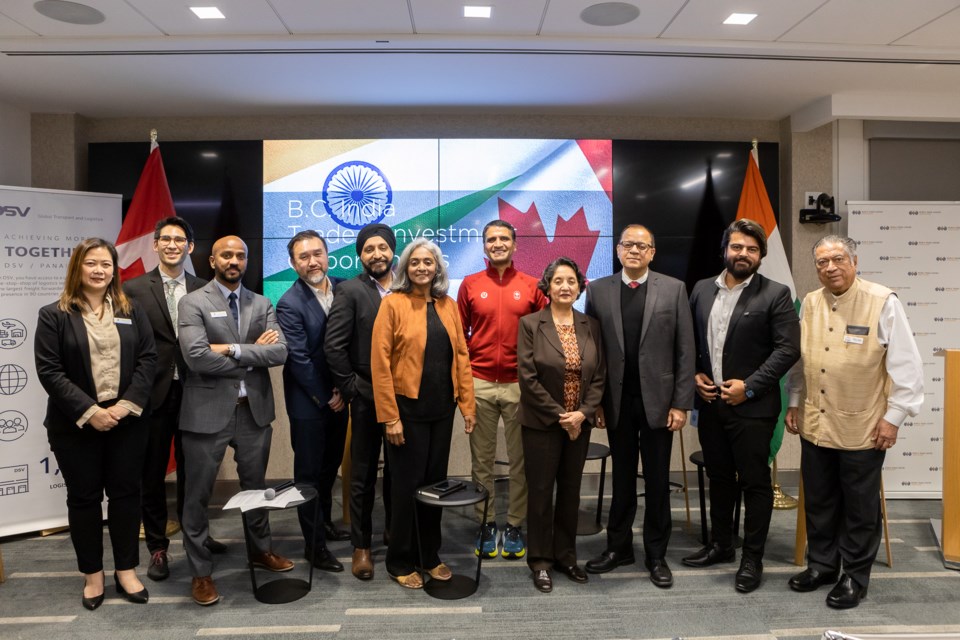The Indo-Pacific agreement will represent "a fundamental shift in bilateral trade opportunities," a Canadian official told attendees at a recent conference.
David Tsui, acting regional director of Global Affairs Canada, stressed the agreement's importance in a panel discussion at KPMG Vancouver last week. The BC-India trade and investment opportunities conference was organized by World Trade Centre, Vancouver, in partnership with BC-India Business Network.
Hosted by the network's president, Sobhana Jaya-Madhavan, the conference highlighted growing opportunities for trade and investment opportunities— not just between Canada and India, but between British Columbia and India as well.
Canada is hoping to strengthen its economic links to the Indo-Pacific region under a new comprehensive strategy, and India would act be a key partner. The two countries are working toward a Comprehensive Economic Partnership Agreement (CEPA) and a Foreign Investment Promotion and Protection Agreement (FIPA), and are exploring ways to deepen their commercial relationship.
According to Tsui, “Wealth has been generated in Asia, people's education levels have grown, infrastructure exists and is growing, consumer appetite has changed,
“And so with every year, the market simply just better for Canadian goods.”
In 2021, India posted the fifth-highest GDP globally at US $3.173 trillion, making it one of the fastest-growing economies in the world.
That growth has consequences for Canada, which has committed to prioritizing the expansion of trade and investment with large, fast-growing markets, including India.
India remains a high-priority trading partner for the Canadian government, which is seeking to expand that trade relationship to its full potential.
The Observatory of Economic Complexity (OEC) notes that exports from Canada to India have increased at an annualized rate of 8.81% during the last 25 years, from US$327 million in 1995 to US$2.7 billion in 2020.
The OEC reported that most of the items exported from Canada to India were dried legumes (at US$524 million), coal briquettes (US$406 million), and potassic fertilizers (US$365 million).
In contrast, in the same year, India exported US$3.26 billion to Canada, around US$560 million more than Canadian exports to India. The report showed that most imports from India were packaged medications (US$335 million), large iron pipes (US$183 million), and crustaceans (US$108 million).
In comparison, during the last 25 years, exports of India to Canada have increased at an annualized rate of 8.75%, from US$400 million in 1995 to US$3.26 billion in 2020.
In his keynote address, Indian Consul Manjish Grover explored the growth of Indian economy and its prospects, highlighting the trade and investment opportunities available.
He noted that India recorded 48 million digital transactions (one per cent of the world's digital transactions) in the past year. China, by comparison, posted just 18 million transactions. Many multinational companies, he added, have begun manufacturing in India, including Samsung and Apple. He noted that Apple has declared that by 2025, 25 per cent of iPhone production will be in India.
“There is a growth potential in India- by 2030, which is the next target that we are actually looking at," he said. "We will be the third-largest economy by GDP; India will have 197 million affluent households.
"By 2030, India's consumption market size will be between $4.8 and $5 trillion. And 20 per cent of the global workforce is going to come out of India ,” he said.
The growth prospects of trade and investment are not limited to India. Canada’s growing economy has a lot potential for bilateral trade opportunities, conference attendees heard. The executive director of B.C.'s International Trade and Investment operation, William Hoyle, said that earlier in the year, the B.C. government launched an economic plan with a focus on sustainability and female-inclusive growth.
“Where I think really the opportunity is for us as a province in our trading relationship with India is entry in services like mobile games, engineering services, professional services, things that don't necessarily cross borders- that we don't put them on a ship, they get there in different ways,” Hoyle said.
“Between 2017 and 2020, B.C. services exports to India doubled. And in 2020, the value of our services exports was $112 million, on par with our goods exports. And as a trade and investment team in the province, this is an area where we've placed some of our efforts, especially over the last few years.”
Grover said that pension funds have cumulatively invested about $55 million in India, with over 600 Canadian companies operating in India and about 1,004 pursuing business in the market. “Last year, Brookfield, Magda, Fairfax, Lululemon [were] some of the bigger names that expanded to India as well as some of the smaller names, small-scale industries.”
He said many Indian companies like TCS, Wipro, Infosys and Tech Mahindra are setting up bases in Canada, highlighting the growing relationship between the two countries. Financial services, renewable energy, construction, education, health care, agritech and information technology are some of the sectors with the most potential and opportunities, he said.
For those interested in investment opportunities and seeking a helping hand, Grover mentioned there are services available for businesses. One is Investopedia, set up by the Indian government, which can act as a guide throughout the process, he said.
“They do market research efforts, help with FDA regulations, consumer market analysis, location search, explanation of important export import duties, help with the combined generations interface with the government if it's needed, and assist with future projects and expansion,” he said. “It's a one-stop shop.”



